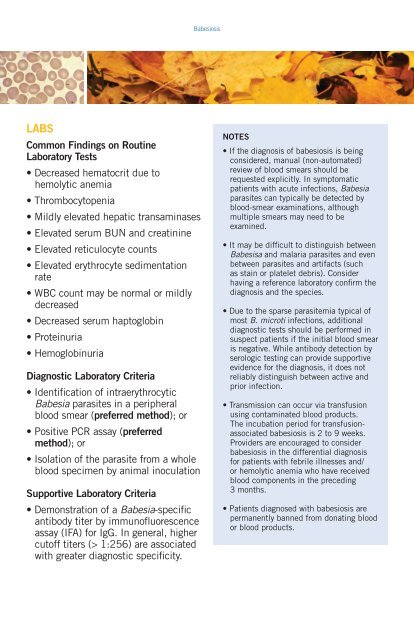tick-borne-dx-physician
tick-borne-dx-physician
tick-borne-dx-physician
You also want an ePaper? Increase the reach of your titles
YUMPU automatically turns print PDFs into web optimized ePapers that Google loves.
Babesiosis<br />
LABS<br />
Common Findings on Routine<br />
Laboratory Tests<br />
• Decreased hematocrit due to<br />
hemolytic anemia<br />
• Thrombocytopenia<br />
• Mildly elevated hepatic transaminases<br />
• Elevated serum BUN and creatinine<br />
• Elevated reticulocyte counts<br />
• Elevated erythrocyte sedimentation<br />
rate<br />
• WBC count may be normal or mildly<br />
decreased<br />
• Decreased serum haptoglobin<br />
• Proteinuria<br />
• Hemoglobinuria<br />
Diagnostic Laboratory Criteria<br />
• Identification of intraerythrocytic<br />
Babesia parasites in a peripheral<br />
blood smear (preferred method); or<br />
• Positive PCR assay (preferred<br />
method); or<br />
• Isolation of the parasite from a whole<br />
blood specimen by animal inoculation<br />
Supportive Laboratory Criteria<br />
• Demonstration of a Babesia-specific<br />
antibody titer by immunofluorescence<br />
assay (IFA) for IgG. In general, higher<br />
cutoff titers (> 1:256) are associated<br />
with greater diagnostic specificity.<br />
NOTES<br />
• If the diagnosis of babesiosis is being<br />
considered, manual (non-automated)<br />
review of blood smears should be<br />
requested explicitly. In symptomatic<br />
patients with acute infections, Babesia<br />
parasites can typically be detected by<br />
blood-smear examinations, although<br />
multiple smears may need to be<br />
examined.<br />
• It may be difficult to distinguish between<br />
Babesisa and malaria parasites and even<br />
between parasites and artifacts (such<br />
as stain or platelet debris). Consider<br />
having a reference laboratory confirm the<br />
diagnosis and the species.<br />
• Due to the sparse parasitemia typical of<br />
most B. microti infections, additional<br />
diagnostic tests should be performed in<br />
suspect patients if the initial blood smear<br />
is negative. While antibody detection by<br />
serologic testing can provide supportive<br />
evidence for the diagnosis, it does not<br />
reliably distinguish between active and<br />
prior infection.<br />
• Transmission can occur via transfusion<br />
using contaminated blood products.<br />
The incubation period for transfusionassociated<br />
babesiosis is 2 to 9 weeks.<br />
Providers are encouraged to consider<br />
babesiosis in the differential diagnosis<br />
for patients with febrile illnesses and/<br />
or hemolytic anemia who have received<br />
blood components in the preceding<br />
3 months.<br />
• Patients diagnosed with babesiosis are<br />
permanently banned from donating blood<br />
or blood products.



